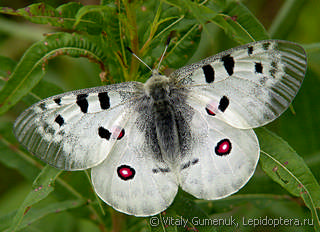Parnassius apollo
Taxonomy
class Insecta
Species name(s)
Parnassius (Parnassius) apollo (Linnaeus, 1758) = Papilio apollo Linnaeus, 1758 = Parnassius apollo (Linnaeus, 1758) = Parnassius apollo nordmanniides Bryk, 1912 = Parnassius apollo lamperti Bryk, 1912 = Parnassius apollo eubohemicus Bryk & Eisner, 1930 = Parnassius apollo agyiens Fruhstorfer, 1921 = Parnassius apollo melliculus Stichel, 1906 = Parnassius apollo pumilus Stichel, 1906 = Parnassius apollo confinis Belling, 1927 = Parnassius apollo sevensis Kesenheimer, 1920 = Parnassius apollo apenninus Stichel, 1907 = Parnassius apollo vistulicus Rebel, 1927 = Parnassius apollo sicinius Fruhstorfer, 1921 = Parnassius apollo alba Rebel & Rogenhofer, 1893 = Parnassius apollo transsylvanicus Schweitzer 1912 = Parnassius apollo thessalicus Bang-Haas, 1934 = Parnassius apollo comes Belling, 1930 = Parnassius apollo vicinus Belling, 1930 = Parnassius Apollo graphicus Stichel, 1899 = Parnassius apollo braniskoi Eisner & Zelny, 1977 = Parnassius Apollo excelsior Stichel, 1899 = Parnassius apollo vinningensis Stichel, 1899 = Parnassius apollo lessei Rougeot & Capdeville, 1968 = Parnassius apollo metaensis Eisner, 1959 = Parnassius apollo burjaticus Nardelli & Hirschfeld, 1994 = Parnassius apollo bosniensis Stichel, 1899 = Parnassius apollo geminus Stichel, 1899 = Parnassius apollo grajus Stichel, 1907 = Parnassius apollo bartholomaeus Stichel, 1899 = Parnassius apollo ventidius Fruhstorfer, 1921 = Parnassius apollo rebelianus Fruhstorfer, 1921 = Parnassius apollo tauricus Bryk & Eisner 1930 = Parnassius apollo turatii Rothschild, 1918 = Parnassius apollo gadorensis Rougeot & Capdeville, 1969 = Parnassius apollo adzharensis Sheljuzhko , 1924 = Parnassius apollo ciscaucasicus Sheljuzhko , 1924 = Parnassius apollo albidociliata Bryk , 1923 = Parnassius apollo andreashoferi Belling & Bryk, 1930 = Parnassius apollo brittingeri Rebel & Rogenhofer, 1893 = Parnassius apollo vilpiana Dannehl, 1933 = Parnassius apollo regius Lukhtanov, 1997 = Parnassius apollo montana Stichel, 1907 = Parnassius apollo nichollae Rougeot & Capdeville, 1972 = Parnassius apollo germainae Rougeot & Capdeville, 1972 = Parnassius apollo laufferi Bryk, 1923 = Parnassius apollo esendei Bryk, 1923 = Parnassius apollo rivalis Belling, 1930 = Parnassius apollo duplex Eisner, 1964 = Parnassius apollo manleyi Wyatt, 1964 = Parnassius apollo kosswigi de Lattin, 1941 = Parnassius apollo limicola Stichel, 1907 = Parnassius apollo suaneticus Arnold, 1909 = Parnassius apollo transiliensis Eisner, 1966 = Parnassius apollo antiquus Eisner & Zelny, 1974 = Parnassius apollo navasi Bryk, 1934 = Parnassius apollo dubius Bryk, 1912 = Parnassius apollo rachelii Eisner, 1975 = Parnassius apollo liburnicus Rebel & Rogenhofer, 1893 = Parnassius apollo carpathicus Rebel & Rogenhofer, 1893 = Parnassius apollo markerti Pfeiffer, 1954 = Parnassius apollo zelnyi Eisner, 1974 = Parnassius apollo minerva Bang-Haas, 1910 = Parnassius apollo carinthicus Stichel, 1907 = Parnassius apollo posthumus Fruhstorfer, 1921 = Parnassius apollo merzbacheri Fruhstorfer, 1906 = Parnassius apollo pandolfus Fruhstorfer, 1922 = Parnassius apollo nivatus Fruhstorfer, 1906 = Parnassius apollo rubidus Fruhstorfer, 1906 = Parnassius apollo chetus Fruhstorfer, 1921 = Parnassius apollo fabrei Rougeot, 1990 = Parnassius apollo victorialis Fruhstorfer, 1921 = Parnassius apollo rhaeticus Fruhstorfer 1906 = Parnassius apollo phrynius Fruhstorfer, 1921 = Parnassius apollo valesiacus Fruhstorfer, 1906 = Parnassius apollo bezauensis Reck, 1939 = Parnassius apollo hahnei Reck, 1938 = Parnassius apollo minor Rebel & Rogenhofer, 1893 = Parnassius apollo caloriferus Fruhstorfer, 1921 = Parnassius apollo turatinus Fruhstorfer, 1921 = Parnassius apollo cognatus Belling, 1928 = Parnassius apollo hoglandicus Kotzsch, 1937 = Parnassius apollo oravensis Eisner & Zelny, 1969 = Parnassius Apollo brunneomaculatus Stichel, 1899 = Parnassius apollo sojoticus Bryk, 1912. [9, 10, 187]
Apollo.
urn:lsid:insecta.pro:taxonomy:8794
Expansion
This species marks on the maps: 7.
Zoogeographical regions
Palaearctic.
Russia regions
#3. Karelsky*; #4. Evropeisky Severo-Zapadny*; #7. Evropeisky yuzhno-tayozhny; #8. Evropeisky Tsentralny; #9. Evropeisky Tsentralno-Chernozyomny; #10. Sredne-Volzhsky; #11. Volgo-Donsky; #13. Zapadno-Kavkazsky; #14. Vostochno-Kavkazsky; #15. Severo-Uralsky; #16. Sredne-Uralsky; #17. Yuzhno-Uralsky; #20. Yuzhno-Zapadnosibirsky; #22. Krasnoyarsky; #23. Predaltaisky; #24. Gorno-Altaisky; #26. Predbaikalsky; #27. Pribaikalsky; #28. Zabaikalsky; #31. Yuzhno-Yakutsky; #36. Sredne-Amursky.
* An asterisk denotes a region for which the species is listed as an migrant or information that requires additional checking.
Forewing length
30—45 mm.
Primary colors
Red, Brown/Gray/Black, White.
Flight time
| January | February | March | April | May | June | July | August | September | October | November | December |
Larva lifespan
| January | February | March | April | May | June | July | August | September | October | November | December |
Detailed information with references
Distribution
Imago Habitus and Differences from alike species
General info about Imago
Imago lifespan
General info about Larva
Larva food plants / other food objects
Larva lifespan
Pupa
Egg
Overwintering stage
Subspecies of Parnassius apollo
- Parnassius apollo alpherakyi Krulikowsky, 1906. [9]
- P. a. democratus Kulikowsky, 1906. [9]
- P. a. finmarchicus Rothschild, 1906. [9]
- P. a. graecus Ziegler, 1901. [9]
- P. a. hesebolus Nordmann, 1851. [9]
- P. a. jelicus Fruhstorfer, 1921. [9]
- P. a. kashtsehenko Sheljuzhko, 1908. [9]
- P. a. leovigildus Fruhstorfer, 1909. [9]
- P. a. limicola Stichel, 1906. [9]
- P. a. meinhardi Sheljuzhko, 1924. [9]
- P. a. merzbacheri Fruhstorfer, 1906. [9]
- P. a. ottonius Fruhstorfer, 1909. [9]
- P. a. provincialis Kheil, 1905. [9]
- P. a. rhea (Poda, 1761). [9]
- P. a. rosenius Fruhstorfer, 1923. [9]
- P. a. sibiricus Nordmann, 1851. [9]
- P. a. suaneticus Arnold, 1909. [9]
Authors
Initial species uploading to the site: Peter Khramov.
Text data: Peter Khramov.
The species characteristics formalization: Peter Khramov.
References
- [1] O. Karsholt, J. Razowski (eds.), 1996. The Lepidoptera of Europe: a distributional checklist
- [3] Каталог чешуекрылых (Lepidoptera) России. Под ред. С. Ю. Синёва. СПб.; М.: Товарищество научных изданий КМК, 2008
- [9] Tree of Life (funet.fi), 2012
- [10] de Jong, Y.S.D.M. (ed.) (2011) Fauna Europaea version 2.4 (faunaeur.org)
- [28] Moths and Butterflies of Europe and North Africa (leps.it), 2012
- [85] Lepidoptera species catalogue, Lepidoptera.ru, 2015
- [187] Species 2000, http://www.sp2000.org
Comments
Note: you should have a Insecta.pro account to upload new topics and comments. Please, create an account or log in to add comments
Parnassius apollo photos















































































All the photos of the species in large size
Please, create an account or log in to upload your photo















